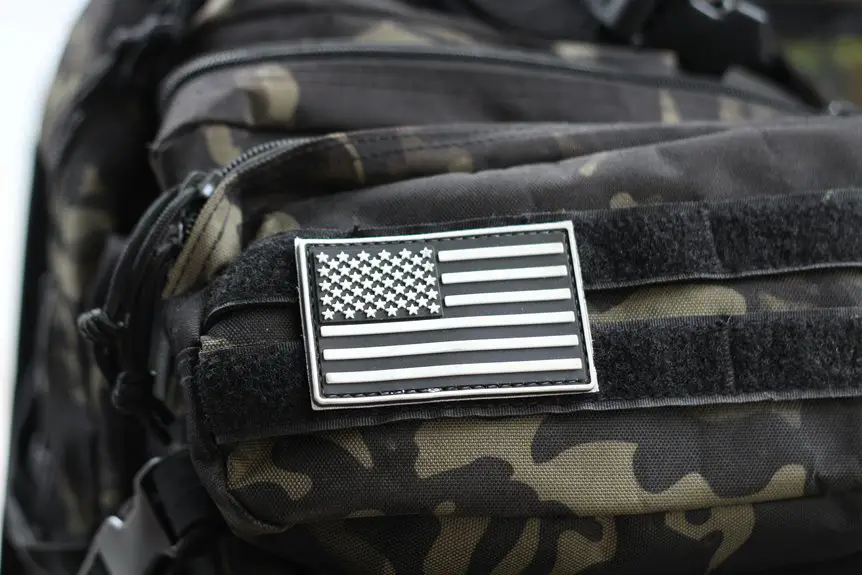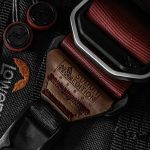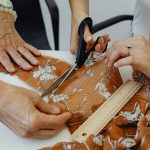You can quickly fix your worn or torn tactical gear using a Kevlar fabric patch, known for its exceptional strength, durability, and heat resistance. These patches match your gear’s weave and thickness to guarantee long-lasting repairs that don’t add bulk or stiffness. Just clean the damaged area, trim frayed edges, and apply the patch securely, reinforcing with sewing if needed. Keep your equipment mission-ready and dependable—explore how to choose, apply, and maintain these patches for the best results.
Table of Contents
Key Takeaways
- Kevlar patches reinforce tactical gear by providing durable, heat-resistant, and flexible repairs to cuts, abrasions, and seam damage.
- Choose patches matching the original Kevlar weave and thickness, and clean the damaged area to ensure strong adhesion and durability.
- Adhesive-backed patches offer quick fixes, while sew-on patches provide longer-lasting strength and reliability for high-stress gear areas.
- Regularly inspect and gently clean patched areas to maintain protection and prevent further wear or patch loosening.
- Kevlar patches extend equipment lifespan, reduce replacement costs, and enable quick field repairs for backpacks, vests, gloves, and pouches.
Understanding the Strength and Properties of Kevlar
Kevlar’s exceptional strength and durability make it an ideal material for tactical gear repairs. When you work with Kevlar fabric, you tap into a material known for its high tensile strength-to-weight ratio, meaning it’s incredibly strong without adding bulk.
This strength comes from its molecular structure—long chains of tightly bonded fibers that resist stretching and tearing. Plus, Kevlar is heat-resistant and won’t easily degrade under harsh conditions, which is essential for tactical gear exposed to extreme environments.
You’ll also appreciate its lightweight nature, keeping your gear manageable during missions. Understanding these properties helps you realize why Kevlar patches restore not just the look but the protective function of your gear, ensuring your equipment remains reliable and durable.
Common Types of Damage to Tactical Gear
You’ll often see wear and tear from constant use, along with abrasion and cuts that weaken the fabric.
Seams and stitches can also get damaged, compromising the gear’s integrity.
Recognizing these common issues helps you know when and how to repair your tactical gear effectively.
Wear and Tear
Although tactical gear is built tough, constant use exposes it to various types of wear and tear that can compromise its performance.
You’ll notice stitching coming loose, weakening seams, and fabric thinning in high-stress areas. Elastic straps can lose their stretch, reducing the gear’s fit and security. Zippers may jam or break, especially when dirt or debris gets inside. Buckles and clips often crack or snap after repeated use.
These issues may seem minor, but they can quickly escalate, leading to gear failure when you need it most. By recognizing these common signs of wear and tear early, you can take action to reinforce or repair your equipment, ensuring it remains reliable and ready for any mission.
Abrasion and Cuts
When you handle tactical gear in rugged environments, abrasion and cuts pose constant threats to its durability.
Rough surfaces, sharp edges, and frequent friction wear down fabric fibers, causing abrasions that weaken your gear over time. Cuts, often from blades or sharp objects, can compromise the structural integrity instantly.
You need to address these damages promptly to maintain protection and functionality. Kevlar fabric patches offer an effective solution by reinforcing worn areas and sealing cuts, restoring strength without adding bulk.
Applying these patches prevents further deterioration and extends your gear’s lifespan, ensuring it stays reliable during critical missions.
Regularly inspect your equipment for abrasions and cuts, and repair them quickly to keep your tactical gear mission-ready.
Seam and Stitch Damage
Beyond abrasions and cuts, seam and stitch damage can seriously compromise your tactical gear’s performance. When seams start to fray or stitches come undone, the structural integrity of your equipment weakens, making it less reliable in critical situations.
You might notice loose threads or small gaps appearing along seams, which can quickly worsen if left unaddressed. Because tactical gear often endures heavy use and extreme conditions, these issues are common.
Fixing seam and stitch damage promptly helps maintain durability and prevents further tearing. Using a Kevlar fabric patch along with reinforcing stitches can restore strength effectively.
Don’t wait for a complete failure—inspect seams regularly and repair minor damage before it escalates into a bigger problem that could jeopardize your mission or safety.
Benefits of Using Kevlar Fabric Patches
Why should you choose Kevlar fabric patches for repairing your tactical gear? Because they offer unmatched durability and protection.
Kevlar is incredibly strong and resistant to cuts, abrasions, and heat, so your gear stays reliable under tough conditions. When you patch with Kevlar, you reinforce weak spots, extending your equipment’s lifespan considerably.
These patches maintain flexibility, ensuring your gear doesn’t become stiff or uncomfortable. Plus, Kevlar’s lightweight nature means you won’t add unnecessary bulk.
You also benefit from easy application—whether you sew or use adhesive-backed patches. By choosing Kevlar, you’re investing in repairs that hold up during demanding missions or outdoor adventures, keeping your gear functional and ready when you need it most.
Choosing the Right Kevlar Patch for Your Equipment
How do you pick the right Kevlar patch for your tactical gear? Start by evaluating the size and location of the damage. Choose a patch that’s slightly larger than the affected area to guarantee full coverage and durability.
Consider the weave and thickness of your gear’s original Kevlar fabric; matching these characteristics helps maintain strength and flexibility. Opt for patches with adhesive backing if you want a quick fix, but for long-lasting repairs, sew-on patches are more reliable.
Also, pick patches in colors and patterns that blend with your gear to keep a low profile. Finally, check the patch’s heat and abrasion resistance ratings to verify it meets the demands of your environment. Selecting wisely means your gear stays mission-ready.
Preparing Tactical Gear for Patch Application
Once you’ve selected the right Kevlar patch, the next step is to prepare your tactical gear for a secure and effective application. Proper preparation guarantees the patch adheres well and lasts longer under tough conditions.
Follow these steps to get your gear ready:
- Clean the Area: Remove dirt, dust, and oils using rubbing alcohol or mild soap; let it dry completely.
- Inspect Damage: Assess tears or wear to guarantee patch placement covers all compromised areas.
- Trim Edges: Smooth frayed fabric edges around the damaged spot to prevent further unraveling.
- Flatten Surface: Lay the gear flat on a hard surface to avoid wrinkles or bubbles during patching.
Taking these precautions sets you up for a durable and professional repair.
Step-by-Step Guide to Applying Kevlar Fabric Patches
Applying a Kevlar fabric patch involves a few precise steps to guarantee a strong, lasting bond with your tactical gear.
First, make sure the damaged area is clean and dry. Trim any loose threads or frayed edges.
Next, position the Kevlar patch over the tear or hole, ensuring it fully covers the damaged spot with some overlap. Press the patch firmly against the fabric to eliminate air bubbles.
If your patch requires heat activation, carefully apply heat according to the manufacturer’s instructions, usually with a heat press or iron on a low setting. Allow the patch to cool and set completely.
Finally, reinforce the edges by sewing around the patch if possible, boosting durability for tough conditions you’ll face.
Tools and Materials Needed for Effective Repairs
Before you start repairing your tactical gear with a Kevlar patch, gather the right tools and materials to guarantee a strong, professional fix.
Having everything ready assures your repair lasts under tough conditions.
- Kevlar Fabric Patch – Choose a patch slightly larger than the damaged area for full coverage.
- Heavy-Duty Needle and Kevlar Thread – Use these to sew the patch securely, as regular thread won’t hold up.
- Fabric Adhesive or High-Temperature Glue – This helps bond the patch before stitching, adding extra strength.
- Scissors and Seam Ripper – Cut precisely and remove any old seams or frayed edges for a clean application.
With these tools and materials, you’ll set yourself up for a reliable, durable repair on your tactical gear.
Maintaining and Caring for Patched Tactical Gear
To keep your patched tactical gear in top shape, you need to clean the patched areas gently but thoroughly.
Regularly inspect the patch integrity to catch any signs of wear or loosening early.
Staying on top of these tasks guarantees your gear remains reliable when you need it most.
Cleaning Patched Areas
When you clean patched areas on your tactical gear, you’ll want to handle them gently to avoid weakening the repair.
Follow these steps to maintain durability and appearance:
- Use a soft brush or cloth to remove loose dirt and debris without scrubbing hard.
- Apply mild soap mixed with lukewarm water; harsh chemicals can degrade Kevlar fibers.
- Gently wipe the patched area, avoiding excessive moisture or soaking.
- Air dry the gear away from direct sunlight or heat sources to prevent fabric damage.
Inspecting Patch Integrity
Regular inspections are key to ensuring your Kevlar fabric patches stay secure and effective. You should examine patched areas for any signs of fraying, lifting edges, or weakened adhesive.
Pay close attention to seams and corners, where stress often causes early wear. If you spot any loose threads or gaps, address them immediately to prevent further damage. Use a bright light and magnifying glass if needed to catch subtle issues.
Additionally, check surrounding fabric for new tears or abrasions that might compromise patch effectiveness. By routinely inspecting your patched gear, you’ll maintain its durability and protective qualities.
Don’t wait for visible damage; early detection helps you perform timely repairs and extends your equipment’s service life. Staying proactive keeps your tactical gear mission-ready.
Comparing Kevlar Patches to Other Repair Materials
Although many repair materials exist, Kevlar patches stand out for their unique combination of strength and flexibility.
Kevlar patches uniquely blend exceptional strength with remarkable flexibility for superior gear repairs.
When you compare Kevlar patches to other options like nylon, canvas, or adhesive tapes, you’ll notice key differences:
- Durability: Kevlar resists abrasion and cuts better than nylon or canvas.
- Heat Resistance: Kevlar withstands high temperatures, unlike most adhesives or synthetic fabrics.
- Weight: Despite its strength, Kevlar remains lightweight, so it won’t weigh down your gear.
- Flexibility: It conforms well to irregular surfaces, unlike stiff canvas or brittle tapes.
You want repairs that last under tough conditions.
Kevlar patches offer unmatched protection and longevity, making them the superior choice for tactical gear repairs.
Real-World Scenarios Where Kevlar Patches Save the Day
Since tactical gear often faces harsh environments, Kevlar patches prove invaluable in critical moments.
Imagine you’re on a mission, and your backpack strap tears. Slapping a Kevlar patch on it stops the damage from worsening, letting you carry essential gear without a hitch.
Or picture your protective vest sustaining a cut during training; a Kevlar patch quickly restores its integrity, keeping you safe.
Even in everyday use, when your gloves or pouches suffer wear and tear, these patches offer tough, reliable fixes.
You don’t have to replace expensive gear or risk failure in the field. Kevlar patches act as your gear’s first responder, ready to reinforce and extend the life of your tactical equipment when you need it most.
Frequently Asked Questions
Can Kevlar Patches Be Used on Non-Tactical Clothing?
Did you know Kevlar is five times stronger than steel? You can definitely use Kevlar patches on non-tactical clothing to boost durability and protection, especially if you want long-lasting, tough fabric for everyday wear or outdoor activities.
Are Kevlar Patches Waterproof or Water-Resistant?
Kevlar patches aren’t inherently waterproof, but they’re naturally water-resistant due to the fibers. You can boost their resistance with a waterproof coating or sealant, helping keep moisture out and extending your gear’s durability in wet conditions.
How Long Do Kevlar Fabric Patches Typically Last?
Think of Kevlar patches as shields—they’ll last years if you treat them right. You’ll find their durability depends on use and care, but typically, they hold strong for several years before needing replacement.
Can Kevlar Patches Withstand Extreme Temperatures?
You’ll find Kevlar patches can handle extreme temperatures well. They resist heat up to about 800°F without degrading, so you can count on them to stay strong and reliable in harsh, hot environments.
Are There Color Options Available for Kevlar Patches?
Oh sure, because Kevlar patches come in neon pink and glittery gold, right? Actually, you’ll find mostly standard colors like black, tan, and olive—perfect for blending in, not a fashion statement, sadly.
- Are All Selvedge Jeans Raw? Debunking a Common Myth - June 24, 2025
- The Perfect Fit: How Tight Should Selvedge Denim Be When You Buy It? - June 24, 2025
- How to Fade Selvedge Denim for High-Contrast Whiskers and Honeycombs - June 24, 2025







